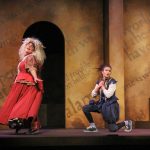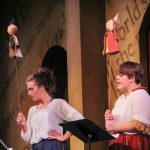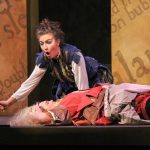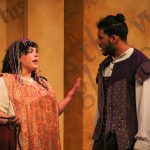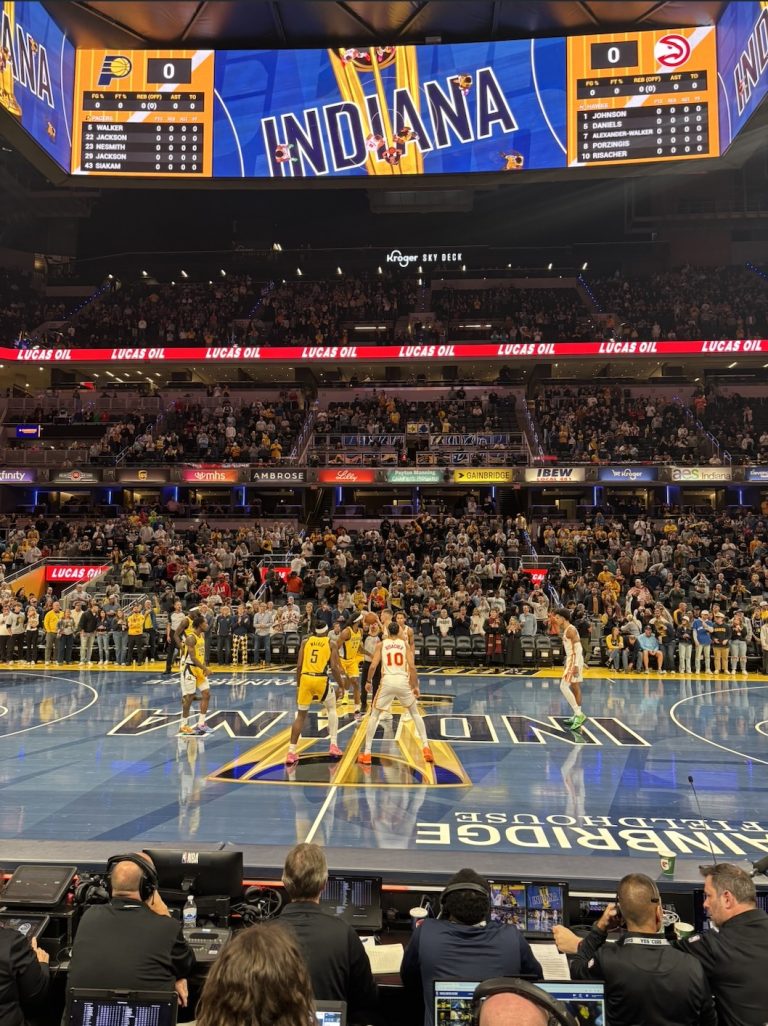The works of William Shakespeare were brought to life on stage by the University of Indianapolis Department of Theatre’s most recent dinner theater production, “The Complete Works of William Shakespeare.”
The performances took place in Schwitzer Student Center’s Dining Hall and was performed Feb. 22-25 and March 1-3 with the dinner being served at 6:45 p.m. and the performance starting at 8 p.m. “The Complete Works of William Shakespeare” is about three theatre
students, Destiny, Noel and Carly, named and portrayed as the real cast members, trying to learn and perform the plays of Shakespeare. Sophomore theatre major Carly Wagers said this was her favorite part.
“The fact that we are so comfortable making fun of our actual selves, and the biggest part was trying to act like we were bad actors,” Wagers said. “We had to perform Shakespeare badly, and its putting yourself out there, being
vulnerable and acting badly, hoping people understand that it’s all part of the comedy.”
The actors perform all 37 of Shakespeare’s plays, and often during the show, would run around the stage and even ended up laying on it. It also featured interaction with the audience, sophomore theatre major Destiny Heugel would often run out into the crowd. The the audience was also encouraged to chant phrases during certain scenes.
“The energy in the audience is what helps keep our energy up,” Heugel said. “When they aren’t as pumped up, then it’s a little more difficult.”
Rehearsals for the play started in mid-January. Guest Director Bill Kincaid casted the three actors and directed the show, his first at UIndy.
“I’ve known a lot of the faculty members [at UIndy] for quite a few years through my work with the Kennedy Center American College Theatre Festival…” Kincaid said. “I knew some of the theatre students, but this is my first time working with them. Everybody has been very enjoyable to work with.”
Kincaid has directed shows ranging from a one person cast to a cast as large as 40 people. The real challenge with a cast of three was that there was a heavy number of lines that they needed to say which made the memorization process really challenging, according to Kincaid.
Although she had never worked with such a small cast before, Heugel said that she had a good experience working with the two other cast members because she was able to get personal time with her director and cast mates and she had more time to work on personal relationships that contributed to the show. Wagers said she enjoyed being part of a small cast because it helped with the chemistry on the stage.
“We can read each other like nothing else,” Wagers said. “If something goes wrong in the show, I can just look at them. We just have these connections where we don’t even have to talk, we just make certain eye contact and we know what we need to do,” Wagers said. “A lot of our performance is [improvisation]. We make up a lot of stuff as we go along, so we have to be able to read the crowd. If the crowd isn’t responding well enough, we can connect with each other and realize what we have to do in order to make it better.”
Sophomore theatre education major Zoe Cunningham is the sound designer for the show and found some of the music that was played before and after the show and during intermission.
“At the beginning of the night when they open the doors, music starts playing and goes until the show starts…” Cunningham said. “We have it at a level where you won’t really hear it because that’s dinner theatre and that’s what people like.”
Another important part of the production was the lighting which was put on by sophomore design and technology major Renee Armstrong. Throughout the show, the cast called for the house lights to be raised and for a spotlight.
“Basically, I have to create a plot with the lights and where I want them positioned,” Armstrong said. “I create different areas on stage and decide how many lights I want, the look I want them to have and their position.”
According to Kincaid, the actors took a lot of creative responsibility for some parts of the performance, which is the way he likes to direct. Kincaid said that it is not him telling people what to do, but it is working towards creating something together. It was a combination of everyone’s ideas working together, including not only Kincaid and the cast, but the designers behind the scenes.
During the performance, the cast had a breakdance scene, which was not part of the script, according to Kincaid. It was something the cast made up themselves and added to theplay.
“One thing about the show is that there is very little plot,” Kincaid said. “It’s more a series of jokes than a plot driven show. In a normal theater driven production, or a sitcom, some kind of problem is presented and [you] watch it be solved, but you don’t really see that happen here. It’s more like just a common theme of Shakespeare [and] a celebration of being silly…”



